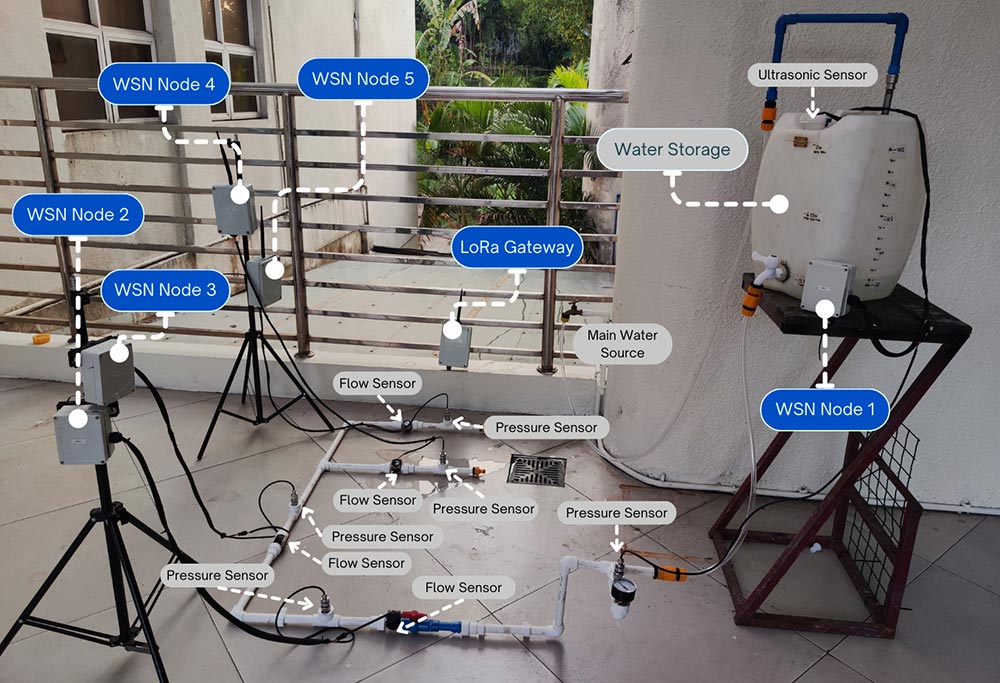April 2025 - A new and younger generation of engineers is starting to experiment with oneM2M standards to address local use cases in ways that show the power of oneM2M to address a multitude of application scenarios. For this interview, we hear from Hazel Gadiaza, a recent graduate of the University of the Philippines Diliman. In it, she describes how she and a team of fellow students designed and implemented a oneM2M-based remote monitoring system for water distribution networks.
Q: Would you begin by introducing yourself and your activities in the IoT arena?
HG: I recently completed my BSc. In Electrical and Electronic Engineering University of the Philippines Diliman, within its Smart Systems Laboratory (SSL). That is where I worked on a group project for my final year thesis.
SSL focuses on “smart” systems that sense their surroundings, operate autonomously, and collaborate with other systems. This involves several key technologies including IoT, cyberphysical systems, wireless sensor networks, and AL/ML.
Q: What can you tell us about your final year project?
HG: Every year, the teaching staff at SSL propose a list of projects for final year students. I chose one that deals with monitoring of water distribution systems, which is important for addressing challenges such as inconsistent water pressure and pipeline leaks that result in revenue losses. Improved water monitoring also benefits the community by ensuring that water is delivered to consumers consistently based on service standards.
The project involved the use of oneM2M because the project advisor, Dr. Jaybie De Guzman, has been following oneM2M for some time. He is drawn to its use in building large-scale, end-to-end systems with distinct hardware, software, and middleware components. Dr. De Guzman came to know about oneM2M while reading about IoT standards from industry. Since oneM2M was supported by ETSI, it was one of the main standards that stood out.
Within SSL, there is a practice of mixing and matching concepts when proposing student projects. Our project is an example that combines IoT, water management, and distributed systems. In the team I worked with, we had zero knowledge of oneM2M at the outset. There was much to learn in addition to dealing with the water distribution system aspects.
Q: How did you tackle the challenge of learning about oneM2M?
HG: There are two parts to it. One was the learning journey, and the other was about the resources we used. In terms of the journey, we had to find resources on-line. Then, we had to navigate through all this information, learn about standardization, and then build the testbed for our project.
The most useful resources we used include oneM2M’s YouTube demonstrators. We found some playlists that are very student friendly and easy to understand. We also dived into a few of oneM2M’s Technical Reports (TR) and Technical Specifications (TS) to understand the topic of semantics. Finally, there are the application developer guides that helped us to implement the communications and the servers, particularly on using oneM2M’s REST API, which was a vital part for the communications part of the project.
As we went through our learning journey, we understood the value of oneM2M, particularly for interoperability and seamless communications. We saw how IoT systems are rich in possibilities but can become overwhelmingly complex. Learning about how standardization can help alleviate this, we were able to implement an organized framework to manage all incoming and outgoing data.
Q: Water distribution systems involve large and distributed infrastructure. How did your team manage the implementation part of your project?
HG: We used a testbed to emulate a real-world water distribution network for our project. This included a network of interconnecting pipes fed from a water tank. The IoT hardware elements included sensors interfaced to microcontrollers.

We built the system’s IP layers on top of oneM2M service layers. For the data transmission, we used oneM2M’s HTTP binding. We used LoRA and Wi-Fi. What oneM2M provided was uniform connectivity, regardless of whatever communications technology is used.
We also implemented oneM2M Middle Nodes (MNs) that act like gateways. They forward sensor data to the oneM2M Infrastructure Node (analogous to a cloud hosted IoT platform). For us, the MN implementation was a critical part of the architecture because this is where oneM2M common services were implemented. This included registration, device management, access control, and data handling.
Through our research, we found an open-source implementation of a CSE (analogous to an IoT platform or middleware). This is the ACME CSE which we deployed across different virtual machines for efficient operation. Through this step, we wanted to show that the system is truly scalable in terms of adding more and more MNs (gateways) while maintaining system efficiency.
The test bed also included an Infrastructure Node (IN), which is also an ACME server that runs on our institution’s servers. The IN handles registration and connectivity of other nodes. In addition, it facilitated the discovery of containers and executed telecommands to end-nodes for control actions.
And the last oneM2M piece was a web application that functions as a monitoring dashboard. This one used the oneM2M REST APIs to allow seamless retrieval, management, and display of data.
Q: How did you go about testing the system?
HG: We had the end-to-end system running with all components operating simultaneously. Then, we had water flowing through the testbed with sensors collecting pressure, volume, and flowrate data and sending this data wirelessly to the MNs (gateways). Then, the monitoring dashboard would request data from the MNs using the REST API.
Q: This project featured in an IEEE conference. Would you tell us a bit more about that?
HG: There is a long-standing tradition within SSL for any team that completes a good project to submit that project and its results to different publications. In our case, we submitted to the IEEE and obtained a presentation slot at the IEEE’s Region 10 Conference (TENCON) in December 2024. An audience member was kind enough to record and post my short presentation. For anybody interested in a long-form description of the project, this is accessible in article format via IEEE Xplore.
Q: Are there any other observations you wish to add in relation to your work?
HG: I have received questions about building on the project and would grab the opportunity to continue working on it if there is interest from big stakeholders or private sector companies. The basic design is not restricted to water distribution systems; it is applicable to other sectors such as energy management, industrial applications, even traffic management or residential use. Interoperability is a key capability with oneM2M. It comes down to switching the sensors – that is all.
I learned a lot from doing the project. I would strongly encourage people and communities to go beyond paper studies to implementation. Theoretical frameworks are really valuable, but impact comes from implementing them. Deploying oneM2M-based IoT systems is a good way to address practical challenges, refine solutions, and witness firsthand how these systems improve lives. I hope to see more communities leverage oneM2M to bring their designs to life and contribute to the growth of smarter and more connected environments.
